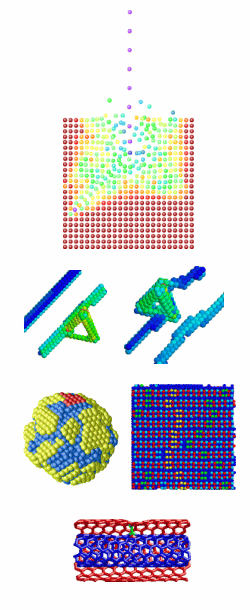Summary in English
Credits: 5 ECTS credit points, (3 study weeks in the old credit system). Prerequisites: Programming skills in C or Fortran90/Fortran95 preferably in the Unix environment; basics of the structure of matter and thermodynamics. The course is also suited to chemists.Contents: Visualization and animation of atomic data. Molecular dynamics simulations, which enable following the motion of a set of pointlike objects (typically but not necessarily atoms). During the course, the students get to write in a supervised manner their own molecular dynamics code, capable of simulating atom motion in simple metals. Genetic algorithm and conjugate gradient energy minimization of atomic systems. Overview of quantum mechanical and classical models of atomic interaction, and a detailed description of modern classical force models for metals, semiconductors, ionic and organic materials.
Literature: Lecture notes.
Yhteenveto suomeksi
Kurssin tarkoituksena on johdattaa opiskelija atomitasolla toimiviin fysikaalisiin simulointimenetelmiin ja antaa valmiudet kirjoittaa simulointikoodeja käytännössä. Kurssin aikana osallistujat kirjoittavat ohjatusti yksinkertaisen simulointikoodin. Opittuja koodausmenetelmiä voi käyttää hyväksi useissa muissakin yleisissä fysikaalisissa simuloinneissa. Lisäksi kurssilla esitellään viimeaikaista kehitystä simulointimenetelmissä ja atomistisissa vuorovaikutusmalleissa tarkoituksena antaa yleiskuva siitä, millaista mallia kannattaa soveltaa mihinkin ongelmaan.Kurssin sisältö: Tietokonesimuloinnit fysiikassa, atomidatan visualisointi ja animointi, molekyylidynaamiset simulointimenetelmät, atomistisista vuorovaikutusmalleista: kvanttimekaanisten, tight-binding- ja semiempiiristen mallien käyttöalueet, geneettiset algoritmit rakenneoptimoinnissa sekä atomistisen simulointidatan vertaaminen kokeisiin.
Laajuus: 5 opintopistettä, (3 opintoviikkoa).

 helsinki.fi)
helsinki.fi)